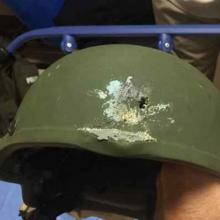The Kevlar helmet that saved an Orlando SWAT officer from a gunshot wound during the nightclub massacre this month is proof of why police need sophisticated equipment, say local unions representing law enforcement agencies.
The issue was raised Wednesday after George Hofstetter, president of the Association for Los Angeles Deputy Sheriffs released a statement saying the mass shooting inside the Pulse nightclub could have been worse if police hadn't been equipped with powerful weapons and tactical gear, including throat, groin, chest and shoulder protection - military equipment that critics say should not be used by local law enforcement
However, Hofstetter said such equipment put officers on even footing with Omar Mateen, the shooter who gunned down 49 people on June 12 just after 2 a.m. The gunman, who proclaimed his allegiance to ISIS, used a powerful Sig Sauer MCX semi-automatic rifle and a Glock 17.
"It should also put to rest the bleeding-heart nonsense that it 'looks bad' to have officers suited up in body armor and riot gear and deployed in armored vehicles," Hofstetter said of the criticism in recent years of police using military equipment.
Since 2014, when television cameras showed heavily armored officers responding to riots and protests in Ferguson, Missouri, over the police shooting of unarmed African-American teenager Michael Brown, law enforcement there and in other cities came under fire for making communities appear like war zones. Police were vilified and the term "militarization" of American police surfaced.
That criticism led to scrutiny of a program operated by the Department of Defense, which has provided municipal police, county sheriffs and school districts with surplus military equipment for 30 years via its "1033 program."
Under the program, the Los Angeles County Sheriff's Department, for example, received nearly 800 M16 rifles in 2013. Protective clothing, electrical equipment and other tools also were obtained.
In response, President Obama signed Executive Order 13688, which regulates what police agencies receive. As a result, some departments are being forced to return their armored vehicles, for example, to the federal government.
"To me it's one of the stupidest things we have heard," said Steve James, president of the Long Beach Police Officers Association. "We are fighting a war. The war on terrorism is here in our country. The problem is the other side doesn't wear a uniform. Having this equipment is just good policy."Advertisement
James said the San Bernardino shooters, who killed 14 people on Dec. 2, 2015, carried powerful assault weapons and improvised explosive devices.
"What are we supposed to do in that situation?" James asked rhetorically. "Are we supposed to go in Ford Crown Victorias with a handgun?"
The American Civil Liberties Union has said that mass shootings are used by law enforcement to justify the acquisition of military equipment.
Once the department acquires military technology, there's an urge to use it, said Peter Bibring, director of police practices and senior staff attorney at the ACLU of Southern California.
"The other thing is, the 1033 program, which was used to acquire this was terribly unregulated," Bibring said. "One of the problems was departments were getting far more gear than could possibly be justified."
The ACLU published a report about it just before Ferguson, Bibring said.
Even school districts received assault rifles and tanks, he added.
Bibring said SWAT was originally created for such situations as active shooters, barricaded suspects and hostage situations.
But James of the Long Beach Police Officers Association and others emphasized that police on patrol can't always wait for SWAT. And the notion of officers showing up in riot gear in every situation is unfair, he added.
"If we get a dispatch for a loud music call and we show up in an armored tank with a bunch of rifles, yeah, that's a problem," James said. "Do we actually need tanks that shoot mortars? That's probably not necessary. But do we need vehicles that can stop a .223 round? You better believe we do."
But all the equipment and training means nothing if there aren't enough police officers, noted Craig Lally, president of the Los Angeles Police Protective League.
"The Los Angeles Police Department is a well-equipped and well-trained police force," Lally said in a statement. "However, all the equipment and training in the world cannot help if we do not have enough officers to mount an effective response."
Lally called the LAPD's daily patrol staffing levels "abysmal" and said the department can't both respond to a mass shooting incident while also safely patrolling the rest of the city.
"This shortcoming must be addressed immediately before tragedies like San Bernardino or Orlando come to our city," he added.
Jorja Leap, an adjunct associate professor of Social Welfare at the UCLA Luskin School of Public Affairs, agreed with the LAPD union president that adequate staffing is important.
"It is more a matter of tactics and strategy than it is equipment," Leap said. "I think it's about staffing, it's about training, and it's about having enough boots on the ground."











